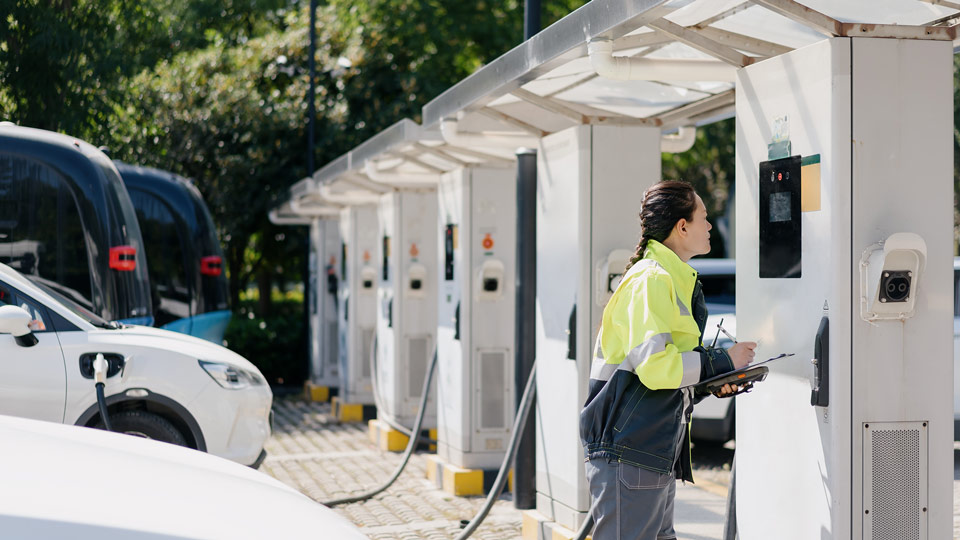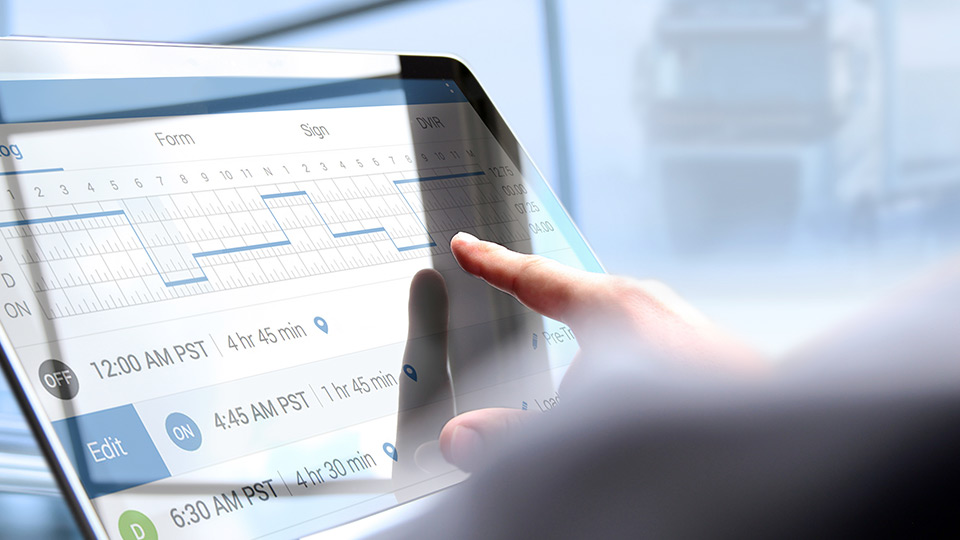
Geotab 2024 discussion recap: A Data-Driven Journey in Fleet Maintenance
Last updated on March 8, 2024 in Public Sector by Andrew Forest | 5 minute read
Table of contents
- Data analytics for fleet maintenance
- Fault diagnostics enrichment, warranty claims and data visualization
- Strategies for preventing breakdowns and excessive costs
- How discovering veiled inefficiencies can enhance maintenance decisions
- Ways that telematics software can add value to vehicle upkeep strategies
- Conclusion
This session at Geotab Connect 2024 highlighted best practices to use data for an effective fleet care plan.
For public sector leaders, one of the key sessions at Geotab Connect 2024 was A Data-Driven Journey in Fleet Maintenance. In this discussion, Geotab speakers Himanshu Gulati, senior product manager, Hannah Jamula-Koke, senior team lead of data and analytics and Ricky Rivera, product manager discussed how to advance your telematics practice. They also spoke about the process for assessing your fleet’s data maturity, what long-term opportunities exist and how to gain strong visuals of your organization’s fleet data. All of these different elements of fleet maintenance are critical to keeping a keen pulse on the health and performance of your vehicles and controlling your bottom-line.
Learn more about the current state of the public sector: Read about our general overview and solutions presentations at Geotab Connect 2024
Data analytics for fleet maintenance
Our speakers started the conversation by talking about the many types of valuable data for fleet maintenance. Using Geotab’s powerful AI-enabled telematics platform, teams can study deep insights about key vehicle maintenance metrics, beyond just meter readings. These include tire pressure anomaly detection, engine oil life predictions, brake check schedules and engine fault incident numbers on the road. However, a “one size fits all” approach usually isn’t as effective for maintaining a whole fleet of vehicles; individualized care plans are often smarter alternatives. By tracking analytics on an individual basis with our solution, public sector organizations can prioritize maintenance for certain vehicles in their fleet to mitigate more expensive future repairs.
Focusing on the right maintenance at the right times and monitoring vehicle health is also essential to providing the best and most cost-efficient service to the public. Ensuring your vehicles remain in optimal condition is how you expand service availability for your constituents and keep everyone – including your employees – safer. Using telematics to collect vehicle diagnostic data can be a valuable way to make your fleet management strategies more proactive and predictive while you fulfill your organization’s duties.
Fault diagnostics enrichment, warranty claims and data visualization
During the discussion, our panelists also addressed how telematics data can help with fault diagnostics enrichment, warranties and the visualization of important information. In the context of fault diagnostics enrichment, Geotab’s platform scours through all engine data and helps filter out lower-priority metrics, so you’re provided with what’s relevant to your vehicles’ most pressing maintenance needs. Grades based on incident severity and their potential effects on vehicle parts are administered automatically and then recommended actions are given.
Fleet management data can play an integral role with original equipment manufacturer (OEM) warranty or policy warranty claims. The Geotab platform enables comprehensive maintenance schedule record keeping for all vehicles in your fleet, making it easier to limit failures, high expenses and losing out on part warranties due to missing documentation. On the roadmap is another tool to help fleet managers become aware of recalls for their fleets. When implemented, the Vehicle Recall information would help fleets reduce multiple visits to service centers, thereby reducing downtime. In addition to warranty management, visualizing fleet data on our maintenance center dashboard enables you to easily make sense of all the other complexities being measured. Inputs from vehicle upkeep schedules, predictive or external events, driver inspections and component faults make up the entirety of the collected maintenance data. Using the maintenance center, you’re able to ingest all this information in a simpler format, helping you better understand individual vehicle costs, which issues need to be addressed first and how much potential downtime to expect.
Strategies for preventing breakdowns and excessive costs
The team spoke about how crafting an effective vehicle replacement strategy starts with analyzing both sides of the fleet maintenance journey. They discussed how the two sides of this journey include the potential breakdown risks in your fleet and the potential impacts of those breakdowns. Using odometer readings, vocation selections and a severity grading scale, breakdown risk estimates can be generated in Geotab’s platform to give fleet managers additional context and indicators of when maintenance may be needed.
When a public sector fleet vehicle breaks down, dealing with the fallout in real time can put additional strain on both budgets and available resources. You should consider factors in advance like a vehicle’s level of importance, what it’s worth and if you have any spare vehicles to do the job in the meantime while it’s repaired. Being mindful of these factors when devising a fleet maintenance strategy can help you prevent breakdowns from occurring as well as limit interference with daily operations. Studying utilization trends in your fleet vehicles can also assist you in identifying which ones are being chronically underused, allowing you to even out wear over time and have backups to rely on if others might need servicing.
Using an electrical system rating (ESR) scale to monitor vehicle battery usage over time should be another important part of your fleet maintenance software toolkit. With Geotab’s ESR capability, you can see when certain vehicle batteries are approaching cautionary levels and take requisite action. By studying data from features like this and others related to repairs, you can expose inefficiencies in your fleet maintenance processes and make informed decisions to solve them.
How discovering veiled inefficiencies can enhance maintenance decisions
With the information gleaned from this discussion, it’s important to take away the most practical ways that all of these features can be used to enhance vehicle maintenance practices.
Collision events: Data collected from collision events can be shared with maintenance teams so that an affected vehicle goes to the workshop quickly, resulting in reduced downtime and better productivity.
Tracking vehicle component statuses: A working electrical system, functional brakes and adequate tire pressure are just three of the many essential components of a healthy vehicle. However, with varying usage rates across all your vehicles, their maintenance schedules likely aren’t always on the same cadence. Making a concerted effort to check these individual vehicle statuses with telematics can help you identify any upcoming upkeep events and prevent small problems from becoming larger ones later on.
Monitoring fault codes: Keeping track of engine fault codes across a large fleet can be difficult without the right technology to do so. If a check engine light illuminates and an employee fails to report it while continuing to drive, expensive repairs and an inability to continue regular operations might soon follow. Keeping your fleet managers in the loop by allowing them to monitor all fault code instances from a telematics dashboard helps reduce this as a possibility and limits serious vehicle damage.
Letting data dictate servicing decisions: Lastly, knowing when the right time is to have maintenance performed is imperative when trying to optimize costs. Fleet maintenance is a balancing act involving making sure you are doing regular necessary maintenance, while at the same time not excessively maintaining your vehicles and wasting money as a result. With the support of analytics, you’ll know precisely when to bring vehicles in for routine servicing each time.
Ways that telematics software can add value to vehicle upkeep strategies
A telematics solution for the public sector can help your organization become more cost-efficient in preserving and managing the health of your vehicles. It also can help your employees drive safer, avoid waste and limit roadside breakdown hazards.
Fleet maintenance software will assist you in meeting compliance and sustainability standards as well. By tracking important inspection information and vehicle usage metrics digitally, the potential for human error or negligence when notating records is reduced. In the rare event of a roadside breakdown, GPS monitoring of an affected vehicle’s position with telematics software even makes the process of providing its exact location to a tow service more efficient.
Conclusion
Geotab’s applications for the public sector extend far beyond simply displaying spatial vehicle data. Our telematics platform is built to collect, report and aggregate all the most critical fleet maintenance data and provide you with needed insights, so you always have the best resources for effective fleet management at your disposal. By utilizing a more data-driven fleet maintenance journey, you can establish a smarter vehicle upkeep strategy and help make better use of your organization’s budget and vehicle downtime.
Click here to book a demo of our solution and learn more about how it can empower your public sector organization to maintain an effective fleet.
If you liked this post, let us know!
Disclaimer
Geotab's blog posts are intended to provide information and encourage discussion on topics of interest to the telematics community at large. Geotab is not providing technical, professional or legal advice through these blog posts. While every effort has been made to ensure the information in this blog post is timely and accurate, errors and omissions may occur, and the information presented here may become out-of-date with the passage of time.
Get industry tips and insights
Sign up for monthly news and tips from our award-winning fleet management blog. You can unsubscribe at any time.
Republish this article for free
Other posts you might like

Boosting public safety operations through integrated technology solutions
April 26, 2024

Public sector fleet electrification: Sharing insights from learned experiences at Connect 2024
April 18, 2024

ELD self-certification: What you need to know
April 10, 2024

The Impact of the California Clean Truck Check on Your Fleet
March 27, 2024






